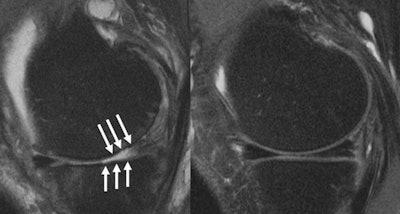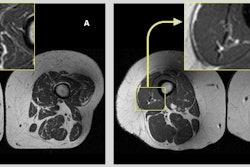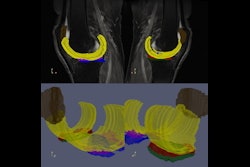CHICAGO – Having stronger thigh muscles may lower the odds of total knee replacement (TKR) surgery in patients with osteoarthritis, according to a study presented November 27 at RSNA 2023 in Chicago.
Presenter Upadhyay Bharadwaj, MD, of the University of California, San Francisco, and colleagues used an MRI deep-learning (DL) model for 3D muscle segmentation to compute thigh muscle volumes in 134 patients with osteoarthritis who either did or did not have total knee replacement (TKR) of a single knee. Participants with stronger muscles underwent fewer surgeries, they found.
“While these results are essential for targeted therapy in a population at risk for osteoarthritis, even the general public can benefit from our results to preventively incorporate appropriate strengthening exercises,” Bharadwaj noted.
Advanced knee osteoarthritis is a major cause of pain and disability worldwide. In the U.S. alone, 14 million adults have symptomatic knee osteoarthritis, and more than half of those diagnosed are projected to eventually undergo TKR surgery.
While stronger muscles are generally associated with a lower rate of TKRs, their relative importance is not well established, Bharadwaj said. Of particular interest is the relationship between the extensors and the hamstrings, the two most important muscle groups in the knee.
To that end, Bharadwaj and colleagues studied 3-tesla MRI patient scans of the thigh obtained at the time of surgery, as well as two years and four years before the surgery. They employed a previously trained DL model to segment and compute volumes of extensors, hamstrings, adductors, gracilis, sartorius, and subcutaneous fat. Then, they analyzed associations between these thigh muscle volume markers and TKR using a longitudinal mixed effects logistic regression model.
 MRI images of a knee joint of a patient showing (left) severe cartilage defects compared to a patient with an intact knee joint. Image courtesy of Upadhyay Bharadwaj, MD
MRI images of a knee joint of a patient showing (left) severe cartilage defects compared to a patient with an intact knee joint. Image courtesy of Upadhyay Bharadwaj, MD
According to the findings, a higher extensor-hamstring ratio was significantly associated with lower odds of TKR (odds ratio [OR]: 0.18, p = 0.005), as well as higher normalized volumes of hamstrings (OR: 0.93, p = 0.002) and gracilis (OR: 0.92, p = 0.01). Muscle volumes for adductors, extensors, and sartorius, as well as subcutaneous fat and absolute muscle volumes, did not show significant association with TKR.
“Our study shows that in addition to strong muscles individually, larger extensor muscle groups – relative to hamstring muscle groups – are significantly associated with lower odds of total knee replacement surgery in two to four years,” Upadhyay Bharadwaj, MD, said.
Ultimately, the study findings have implications for both the interpretation of imaging exams and clinical management, according to the researchers, and suggest that training programs that strengthen the quadriceps in relation to the hamstrings may be beneficial.
“Although we presume that overall muscle volume is important as a surrogate marker for muscle strength, the ratio, hence the balance, between extensor and hamstring muscles may be more important and significantly associated with lower odds of total knee replacement,” Bharadwaj concluded.



















